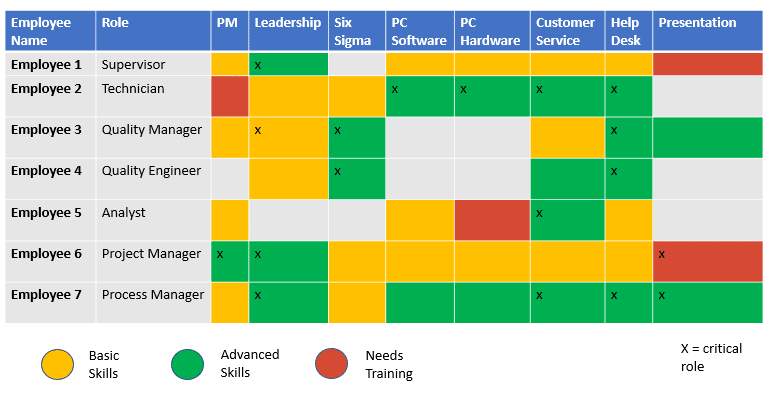What is a Competency Matrix?
Role Competency Matrix (RCM) is a graphical representation of the roles and competencies of the employees in an organization.
It is a tool that highlights which competencies exist within your company and what your employees strengths are. Moreover, RCM also uncovers the weaknesses and pitfalls of your employee’s competencies. RCM is designed to help you define and visualize your employees skillset and required competencies.
Importance of Role Competency Matrix (RCM)
- Highlighting Employee Competencies:
- RCM brings into focus the competencies that exist within the organization, providing a detailed overview of the skills and strengths present among employees.
- Identifying Strengths and Weaknesses:
- Beyond showcasing competencies, RCM also reveals the weaknesses and pitfalls in employees’ skill sets. This insight is invaluable for targeted skill development and improvement initiatives.
- Defining and Visualizing Skillsets:
- RCM is designed to help define and visualize employees’ skillsets and the competencies required for their respective roles. This clarity ensures that employees and managers have a shared understanding of the skills needed for success.
- Utilization for Business Objectives:
- RCM plays a crucial role in aligning employee competencies with business objectives. It helps in developing the specific competencies required to fulfill organizational goals.
- Identifying Competency Gaps:
- An integral aspect of RCM is the identification of competency gaps. Recognizing areas where skills are lacking enables organizations to strategize and implement training programs for targeted skill enhancement.
- Base for Training Programs:
- RCM serves as a foundational tool for developing training programs. By understanding the existing competencies and areas for improvement, organizations can tailor training initiatives to address specific needs.
- Setting a Vision for Professional Development:
- The competency matrix sets a clear vision for professional development. It outlines the skills and competencies that individuals can aim to acquire or enhance, fostering a culture of continuous improvement.
- Recruitment Enhancement:
- With a detailed understanding of the competencies within the organization, RCM can inform recruitment strategies. It aids in attracting and selecting higher-quality staff who align with the required skill profiles.
Steps to Build a Competency Matrix
- Define Employees and Job Roles:
- Clearly define the employees and their respective job roles within the organization.
- Determine Needed Skills:
- Identify the skills and competencies required for each specific job role.
- Create Assessment Method:
- Develop a method of assessment, such as categorizing competencies into levels (e.g., expert, practitioner, novice), and evaluate each team member’s competencies.
- Reflect and Develop:
- Reflect on the data gathered through the competency matrix and strategize ways to develop and enhance the missing skills. This may involve creating targeted training programs or mentorship initiatives.
In essence, a Competency Matrix, particularly when integrated with Role Competency Matrix (RCM), serves as a dynamic tool for understanding, developing, and aligning employee competencies with organizational objectives, ultimately contributing to sustained success and growth.
RCM Example
The competency matrix comes in various templates. Here is one example of how it can look like. What to use this template? Download it here.

Further resources:
- Lean recruitment – avoid hiring a gourmet chef for flipping burgers
- RCM (Karuba M., 2019), Springer.
Related Links:
Explore more about different process improvement terms in our BPM Glossary.
